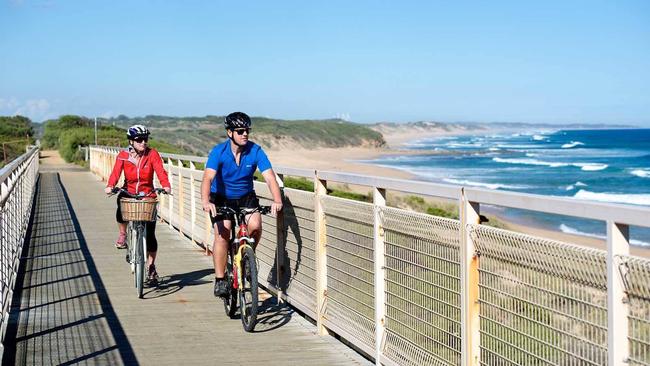Right to farm: Farmers battle sea changers and planners
Farmers say their rights to harvest a crop, wean cattle and build a fence are being undermined by sea changers complaining about bellowing cows and threatening legal action.

Farmers say their right to harvest a crop, wean cattle, and even build a stock fence are being undermined by sea changers and overzealous planners more focused on tourism and preserving rural views than agriculture.
The Department of Environment, Land, Water and Planning is moving ahead with plans to impose significant landscape overlays that force farmers to gain a permit before building a fence on the Bass Coast and effectively ban corrugated-iron sheds on sites near tourist routes on the Bellarine Peninsula and Surf Coast.
Farmers say they are already battling to undertake the most basic work, as sea and tree changers snap up neighbouring rural lots, without understanding they are moving into a primary production zone, where they will be exposed to noise, dust and odours.
Portarlington farmer Noel Vallance said he has been twice threatened with legal action, after the dust he created while stripping wheat and canola crops settled on a neighbouring lifestyle block owners’ cars, one of which was a Maserati.
“He rang me, swearing and cursing, about the dust going over his cars and into his swimming pool,” Mr Vallance said.
“He sent me a letter saying he’d been talking to his solicitor and texts saying I’d have to pay for all his cars to be cleaned, especially his Maserati, because it’d have to be sent to Melbourne to be specially detailed, cut and polished.”
Other farmers told The Weekly Times of neighbours threatening to shoot their stock and police knocking at their doors late at night.
“I was weaning some calves and their bellowing irritated the neighbour, who threatened to shoot them,” one Bellarine Peninsula farmer said. “It’s getting difficult as we’re getting closed in by houses.”
Another farming family recounted having two police officers drive up to their house at 10:30pm on a Saturday, at a time when their 22-year-old son had gone to Melbourne with friends and their other two adult children were overseas.
“The first thing they (the police) said was there was nothing to worry about, they were just responding to (neighbours’) reports of cattle in distress,” the Peninsula farmer said. “I had to assure them the weaners were in the yard (bellowing) and their mums couldn’t give a stuff.”
In its submission to the Government’s latest proposal to create more significant landscape overlays, the Victorian Farmers Federation’s Bellarine Peninsula branch warned land-use conflicts would be “further exacerbated by state planning policies that prioritise tourism over agriculture”.
“The VFF believe that farmers’ right to farm should not be eroded by secondary uses which create land use conflict, this includes tourism,” the submission reads.
“The Statement of Planning Policy needs to understand that the farms located on the Bellarine Peninsula are working farms and not just there for nice landscape views.”
DELWP also wants to protect rural views around Phillip Island and along the Bass Coast hinterland by imposing significant landscape overlays that force farmers to:
CONSTRUCT sheds using external materials and colours that minimise its visibility in the landscape
GAIN a permit to construct a fence (this does not apply to a post and rail fence up to 1.8 metres in height).
GAIN a permit to remove, destroy or lop exotic tree rows or shelterbelts, such as cypress or other non-native species.
The draft statement of planning policy highlights the need for these controls to “protect and enhance the declared area’s significant landscapes, with their many views, panoramic seascapes, rugged coastlines, tranquil wetlands, elevated rural hinterland and idyllic pastoral landscapes s of rolling rises and gullies”.
VFF leadership has warned there is an urban bias in the planning system that sees farming land as vacant or awaiting an urban use.
Parliament’s Upper House is already running an inquiry into the adequacy of the Planning and Environment Act 1987, with the VFF recently lodging a submission that warned the 2011 decision by the former Coalition Government had downgraded agriculture by redefining it as part a region’s natural resources, like water, rather than an economic development activity.
“Agriculture was taken out of industry/economic development and placed in natural resources with water,” the VFF submitted.
“This has had significant repercussions regarding the operation of planning and matters that are taken into consideration, even to the point of tourism being given preference in the Farming Zone at VCAT at the expense of agriculture, due to the fact tourism is considered an economic development good.”
Victorian Planning Minister Richard Wynne’s office said the proposed significant landscape overlays for the Surf and Bass coasts “do not represent a ban on corrugated-iron sheds other buildings and are similar to existing landscape overlays”.
However the overlays demand farmers gain a permit to build a standard post and wire fence in the Bass Coast SLOs and that in all SLOs buildings are “constructed using external materials and colours thatminimise its visibility in the landscape”.




